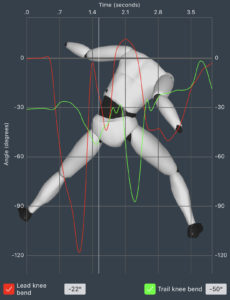 Just like hitters work to find the "Sweet Spot" of the bat when they want to crush the ball into the gap or out of the park, hard-throwing pitchers work to also hit their "Sweet Spot" when they want to increase stride power and blow the ball by a hitter. A Pitcher's "Sweet Spot" occurs in the drive leg when they have built optimal flexion moving forward from their leg lift into triple extension. This position in the 3X Mechanics is called the "Load" position. This is the position where the pitcher is loaded and ready to launch, to build stride power.
Just like hitters work to find the "Sweet Spot" of the bat when they want to crush the ball into the gap or out of the park, hard-throwing pitchers work to also hit their "Sweet Spot" when they want to increase stride power and blow the ball by a hitter. A Pitcher's "Sweet Spot" occurs in the drive leg when they have built optimal flexion moving forward from their leg lift into triple extension. This position in the 3X Mechanics is called the "Load" position. This is the position where the pitcher is loaded and ready to launch, to build stride power.
Vertical Jump Test
A pitcher's "Sweet Spot" is best understood when related to a vertical jump. You can try this test as you read this article. First, start with your feet shoulder-width apart then try to jump as high as you can without bending or flexing your knees. Once you have tried this a few times then start again with your feet shoulder-width apart and your butt on the floor, if possible. This means you are in a full squat position. Now try to jump as high as you can. After you have done this a few times then start again in the same position but this time drop your butt to a position that is in between the two. This means your knees are not locked and your butt is not all the way down to the floor. Try to find your "Sweet Spot" when you perform the next jump. This "Sweet Spot" is a position that you feel you can quickly move out of with as much flexion as possible.
Now that you have performed all three jumps, you should have a good understanding of how effective finding your "Sweet Spot" is in your overall power production, based on how high you were able to jump.
Find Your Pitching "Sweet Spot"
Just like in the vertical jump test, you need to find your same "Sweet Spot" when in your pitching "Load" position. The difference with pitching is that it is a linear explosive movement instead of a vertical explosive movement, like with the jump. This means your "Sweet Spot" is more than just having good power production through optimal drive leg flexion. It is critical that you have aligned your force vector into a linear position during this "Load" position to help keep your body moving forward and accelerating towards the target. If you are late with aligning your force vector then this could slow down your stride speed and reduce power production.
The aligning of your force vector, as you build flexion in your drive leg, helps create more of a forward load as you build flexion. If the force vector stays vertical as you move into your "Load" position then you are not moving forward and your stride speed is now slowing down. Notice the clip of Brandon Morrow above, he is aligning his force vector while he is building flexion and moving into his "Load" position. He is obviously hitting his "Sweet Spot" here because before his explosive triple extension, he has developed good flexion in his drive leg and his force vector is in line with his front hip. This, along with his explosive leg power, is why Brandon has one of the most powerful strides in the game.
If you are struggling with finding your "Sweet Spot" in your "Load" position then you more than likely are dealing with a strength and/or power issue. If you have poor leg strength, you will find that building flexion in your drive's leg can be a challenge. If you have average to above average leg strength but you are struggling with accelerating through your "Load" position then you are dealing with an explosive speed or power issue. The 3X Pitching Velocity program is one of the only Velocity programs on the market that use both the throwing program and the strength and conditioning program together to enhance your "Sweet Spot" and increase velocity. This means the Fusion system which is the strength and conditioning program, is developing not only leg strength but leg power, and the 3X Velocity system or throwing program is helping you program the new muscle development to move through the 3X mechanics. This is the only way you are going to find and enhance your pitching "Sweet Spot" and drastically increase your pitching velocity.



